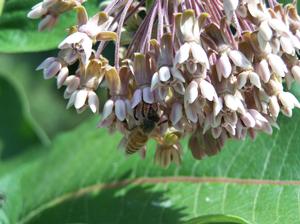
1. a honeybee on milkweed, Asclepias syriaca - a quintessential meadow plant very important to Monarch Butterflies and caterpillars
Lawns Part VI: The Wildflower Meadow - An Exuberant Hats-off to the American Prairie
In part VI of the Lawn and Groundcover series, we break from the conceptual lawn. We have come to understand in part I why the “chemical lawn” is not in the best interests of the planet. We know that the “organic lawn” is not only possible but the responsible, sustainable imperative in part II. We have considered “alternative plantings”, shrubs and perennials clustered in areas where grasses once grew or where lawn simply languished in parts III, IV and V. But perhaps you’ve reached a point at which you wish to do away altogether with your traditional lawn. Maybe you’ve had enough of the maintenance, the costs in time and fossil fuels. Possibly you’ve reached a threshold in your spiritual growth and understanding of the greater good to which the elimination of lawn is a necessary reflection of personal epiphany. Perchance you wish to give back to the wildlife with who we share the world.
Under full sun the wildflower meadow is an exuberant hats-off to the American prairie. Wildflower meadows bloom profusely with nodding cups and striking spikes, daisy landing pads and glimmering trumpets. The wildlife will rejoice! Goldfinches happily retrieve seed from husks. Butterflies and moths of all spots and stripes cavort from flower to flower dipping into the rich nectars of the season (see pic 1). Native bee populations – species I’ll bet you never even knew existed busily work gathering food for the hives as they aid in pollinating next year’s batch of seedlings.
Creating a wildflower meadow is not as simple as strewing the contents of a packet of seed on barren ground. You must first eradicate any unwanted plants then sow the seed then follow carefully the instructions on the seed packet. Various seed blends are available that are appropriate to particular regions of the country. Be certain to link the cultural needs of the mix to the tract you wish to convert. Close observation of your newly sown meadow is required. Hand-weeding is necessary to eradicate unwanted plants that can overtake tender sprouts. Unless the section is a narrow strip enter the area with care as it may be all too easy to trample seedlings of the very plants you are trying to nurture. Planting “plugs” or collections of young plants will increase success; though it’s a more expensive option plantlets may have a fighting chance against aggressive weeds that might easily overwhelm seedlings. Watering will be necessary in establishing especially in hot and dry spells. The area will have to be mowed at least once, late season after the birds have migrated and insects have had their day in the sun. Though front-loaded labor-intensive this possibility can be extraordinarily beautiful, mesmeric in summer breezes, and diminish high-maintenance lawn requirements.
Equally loved by wildlife and easier to cultivate would be a field of native asters, Joe-pye weeds (Eupatorium), perennial sunflowers (Helianthus - see pic 2), butterfly weed (see pic 3) and milkweeds (Asclepias), ironweed (Vernonia), black-eyed Susans (Rudbeckia), fleabane (Erigeron), thistle (see pic 4), sedge, chickory and goldenrod (Solidago). Incidentally, contrary to popular myth goldenrods do not contribute to hay fever allergies, their pollen grains are too large and heavy to be carried on the winds generally dropping to the ground in close proximity to the mother plant. Likely, the actual misery causing culprit is common ragweed.
In a larger sunny field our native Sumacs (Rhus) colonize making a fabulous display that is interesting if not downright beautiful in all 4 seasons. There are cut-leaf forms that appear delicate but are just as tough as their normal-leafed brethren. They can be under planted with ferns and other native perennials and flowers that will groundcover and aid in weed suppression.
“Devil’s Walking Stick” (Aralia spinosa) will make a spectacular large-scale groundcover in full to part sun. It has huge fern-like leaves, enormous white puffy panicles and remarkable clusters of dark purple berries late season. Place this one in an open area for it will spread and cover with ease. The thorny stems from which its namesake derives are not for the faint of heart for once the beautiful leaves drop it is definitely a plant that Morticia Adams would love!
Our native Red Cedar (Juniperus virginiana), an important bird plant, is one of the first species, a “pioneer species”, to erupt from disturbed ground in full to part sun on draining soils. They can be endlessly fascinating as it is a very variable species. Plant a grove. Once they are big enough to cast shade - and they can stretch skyward quickly, under plant with ferns and other groundcovers that grow an attractive thicket through which weed species will have difficulty taking hold. When they have grown tall erect a hammock under their cool shade where lawn once inhabited and gently swing into the slumber of summer daydreams!
Penned by Wayne Paquette, Winter 2007

